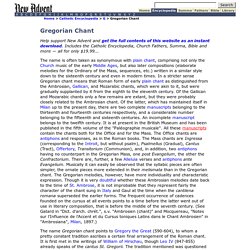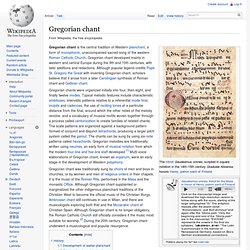

Gregorian Chant Notation. Gregorian chant (music) - Britannica Online Encyclopedia. Gregorian Chant. Help support New Advent and get the full contents of this website as an instant download.

Includes the Catholic Encyclopedia, Church Fathers, Summa, Bible and more — all for only $19.99... The name is often taken as synonymous with plain chant, comprising not only the Church music of the early Middle Ages, but also later compositions (elaborate melodies for the Ordinary of the Mass, sequences, etc.) written in a similar style down to the sixteenth century and even in modern times. In a stricter sense Gregorian chant means that Roman form of early plain chant as distinguished from the Ambrosian, Gallican, and Mozarabic chants, which were akin to it, but were gradually supplanted by it from the eighth to the eleventh century. Of the Gallican and Mozarabic chants only a few remains are extant, but they were probably closely related to the Ambrosian chant.
The principal proofs for a Gregorian tradition may be summarized thus: Abbaye de Solesmes - Histoire du Chant Grégorien. Gregorian Chant is a musical repertory made up of chants used in the liturgical services of the Roman Catholic Church.

In fact, the liturgical tradition which the Church has given us is a vocal, monophonic music composed in Latin using sacred texts from the Ancient and New Testaments. This is why Gregorian Chant has often been called a "sung Bible". Linked intimately to the liturgy in this way, the goal of the Gregorian melodies is to favor spiritual growth, reveal the gifts of God and the full coherence of the Christian message. What we call Gregorian chant today first appears distinctly in the Roman repertory of the fifth and sixth centuries. Gregorian chant. Gregorian chant is the central tradition of Western plainchant, a form of monophonic, unaccompanied sacred song of the western Roman Catholic Church.

Gregorian chant developed mainly in western and central Europe during the 9th and 10th centuries, with later additions and redactions. Although popular legend credits Pope St. Gregory the Great with inventing Gregorian chant, scholars believe that it arose from a later Carolingian synthesis of Roman chant and Gallican chant.